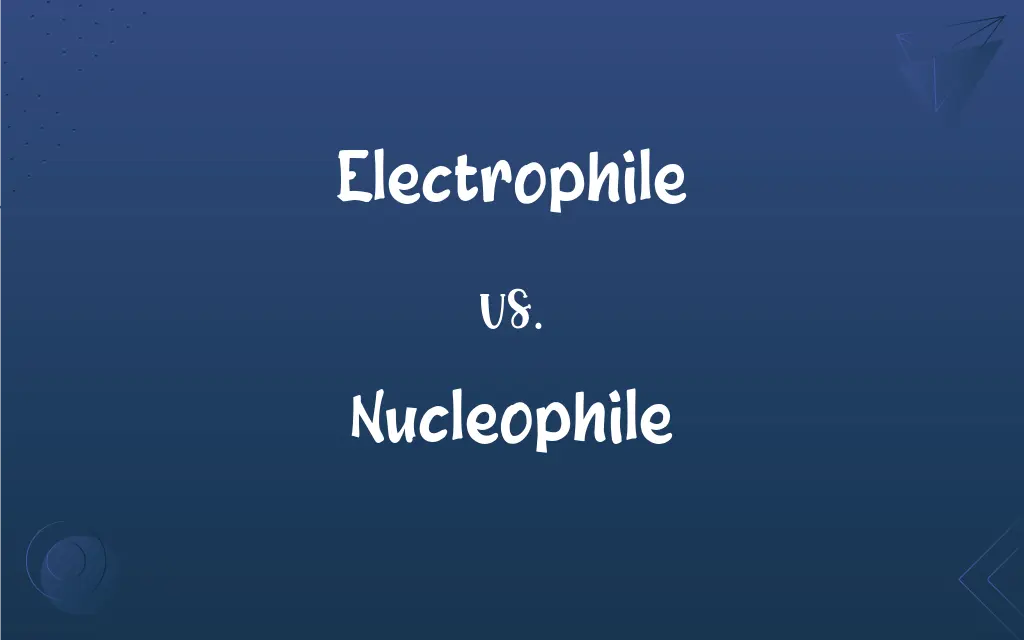Electrophile vs. Nucleophile: What's the Difference?
Edited by Janet White || By Harlon Moss || Updated on October 20, 2023
Electrophiles are species seeking electrons, while nucleophiles are species donating electrons.

Key Differences
Electrophiles and nucleophiles are foundational concepts in organic chemistry, driving many reactions. An electrophile is typically a molecule or ion that is electron-poor and has an affinity for electrons. It "loves" electrons and tends to attract them. Conversely, a nucleophile is an electron-rich molecule or ion, which has a propensity to donate its electrons. Essentially, nucleophiles "love" nuclei because nuclei are positively charged and electrons are negatively charged.
Understanding the behavior of electrophiles and nucleophiles is crucial for predicting reaction mechanisms in organic chemistry. Electrophiles often have positive charges or positive polarized regions, making them receptive to electron-rich species. On the other hand, nucleophiles often possess lone pairs or π bonds that can be donated during reactions. These species are typically negatively charged or have negatively polarized regions.
The interaction between electrophiles and nucleophiles is central to many chemical reactions. For example, in a basic addition reaction, an electrophile will react with a nucleophile, leading to the breaking and forming of bonds. This complementary nature, where the electron-deficient electrophile seeks out the electron-rich nucleophile, facilitates countless chemical processes.
Electrophilic and nucleophilic reactions play an essential role in synthesizing many organic compounds. Electrophiles can be generated in multiple ways, such as by protonation of a molecule. Nucleophiles, conversely, can be a variety of species including water, alcohols, or amines. Mastery of these concepts is fundamental for chemists to understand, predict, and control organic reactions.
Comparison Chart
Electron Affinity
Attracts electrons
Donates electrons
ADVERTISEMENT
Typical Characteristic
Electron-poor
Electron-rich
Charge
Often positive or partially positive
Often negative or partially negative
Common Behavior
Accepts electron pairs
Provides electron pairs
Role in Reactions
Reacts with electron donors
Reacts with electron acceptors
Electrophile and Nucleophile Definitions
Electrophile
An electron-deficient atom or molecule.
The carbocation is a classic example of an electrophile in organic reactions.
ADVERTISEMENT
Nucleophile
A species that donates electrons during chemical reactions.
In a substitution reaction, hydroxide acts as a nucleophile, donating electrons to the substrate.
Electrophile
A molecule or ion that can accept an electron pair.
In the Friedel-Crafts reaction, the acylium ion behaves as an electrophile.
Nucleophile
A molecule or ion that can donate an electron pair.
In nucleophilic substitution, the bromide ion behaves as a nucleophile.
Electrophile
A species that seeks electrons during chemical reactions.
In the reaction, bromine acts as an electrophile, accepting electrons from the alkene.
Nucleophile
An electron-rich atom or molecule.
The ammonia molecule, with its lone pair, is a potent nucleophile.
Electrophile
A reagent attracted to regions of negative charge or high electron density.
In the presence of alkenes, the hydrogen ion serves as an electrophile.
Nucleophile
A reagent attracted to regions of positive charge or low electron density.
Water, possessing lone pairs, can serve as a nucleophile in hydrolysis reactions.
Electrophile
An entity forming a bond by accepting electrons from a nucleophile.
The positively charged carbon in a carbocation readily acts as an electrophile.
Nucleophile
An entity forming a bond by donating electrons to an electrophile.
The negatively charged oxygen in a hydroxide ion often acts as a nucleophile.
Electrophile
An electron-deficient chemical compound or group that is attracted to electrons and tends to accept electrons. Also called Lewis acid.
Nucleophile
An electron-rich chemical compound or group that is attracted to nuclei and tends to donate or share electrons. Also called Lewis base.
Electrophile
(chemistry) A compound or functional group that is attractive to, and accepts electrons, especially accepting an electron pair from a nucleophile to form a bond.
Nucleophile
(chemistry) A compound or functional group that is attractive to centres of positive charge, and donates electrons, especially donating an electron pair to an electrophile to form a bond.
FAQs
Are nucleophiles typically electron-rich or electron-poor?
Nucleophiles are typically electron-rich.
Can water serve as a nucleophile?
Yes, water can act as a nucleophile due to its lone pairs of electrons.
Can a molecule act as both an electrophile and nucleophile?
Yes, some molecules can exhibit both electrophilic and nucleophilic behavior depending on the context.
Can negatively charged ions act as nucleophiles?
Yes, negatively charged ions, like hydroxide, often act as nucleophiles.
Are cations always electrophiles?
Not always, but many cations, especially those that are electron-deficient, act as electrophiles.
Can bases be nucleophiles?
Yes, many bases can act as nucleophiles because they have electron pairs available for donation.
Which is typically more reactive: a strong electrophile or a weak electrophile?
A strong electrophile is typically more reactive.
Is a carbocation an electrophile or nucleophile?
A carbocation is an electrophile.
Why are lone pairs significant for nucleophiles?
Lone pairs on nucleophiles can be donated during reactions, making them essential for nucleophilic behavior.
Can steric hindrance affect the reactivity of nucleophiles?
Yes, bulky nucleophiles can be less reactive due to steric hindrance.
What is the primary function of an electrophile in a reaction?
Electrophiles seek and accept electrons from nucleophiles.
What drives the interaction between electrophiles and nucleophiles?
The electron-seeking nature of electrophiles and the electron-donating propensity of nucleophiles drive their interaction.
Can a neutral molecule act as an electrophile?
Yes, if it has an electron-poor or positively polarized region, a neutral molecule can act as an electrophile.
Are all nucleophiles negatively charged?
No, while many nucleophiles are negatively charged, others can be neutral but have electron-rich regions.
Is it correct to say that electrophiles "seek" electrons?
Yes, electrophiles typically "seek" or are attracted to electron-rich regions or species.
How can one identify a molecule as an electrophile or nucleophile?
Look for charge distribution; electron-poor regions indicate electrophiles, while electron-rich areas suggest nucleophiles.
Do all electrophilic reactions involve nucleophiles?
Typically, yes. Electrophilic reactions usually involve an interaction with a nucleophile.
What is a common characteristic of electrophiles?
Electrophiles are often positively charged or have positively polarized regions.
Can a molecule with multiple electron-rich sites act as a multidentate nucleophile?
Yes, molecules with multiple electron-donating sites can interact with several electrophiles simultaneously.
How are nucleophiles important in organic synthesis?
Nucleophiles are crucial for many reactions, like nucleophilic substitutions or additions.
About Author
Written by
Harlon MossHarlon is a seasoned quality moderator and accomplished content writer for Difference Wiki. An alumnus of the prestigious University of California, he earned his degree in Computer Science. Leveraging his academic background, Harlon brings a meticulous and informed perspective to his work, ensuring content accuracy and excellence.
Edited by
Janet WhiteJanet White has been an esteemed writer and blogger for Difference Wiki. Holding a Master's degree in Science and Medical Journalism from the prestigious Boston University, she has consistently demonstrated her expertise and passion for her field. When she's not immersed in her work, Janet relishes her time exercising, delving into a good book, and cherishing moments with friends and family.































































